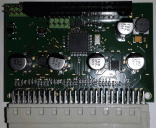Stepper motor driver incorporating a propeller
 ErNa
Posts: 1,842
ErNa
Posts: 1,842
Today we received the PCB's for our latest QS-Format board, and the propeller is already alive (can be found). Now we will go forward step by step with testing, features are: 24V, switching power supply to create plenty of 5 V, 4 stepper drivers, two limit switches and AB/N quadrature encoder input per channel. Firmware will implement a spi interface to the QS-Bus and 4 board will be jumper selectable. In addition there is a isolated full duplex RS485, so the board can run stand alone, only serial connection to command the drivers is needed. The propeller works from a 128KByte flash memory. There is a vision to connect an IoT5500 board to attach the box to the internet.




Comments
drivers with stall detect and it wasn't really usable.
Still the on-resistances are pretty low, the lowest I've seen for a one-chip chopper.
Normally a stepper is driven at nominal current what means constant dissipation of power. The cool step feature detect the motor load and reduces current to the value needed to generate appropriate torque. When load increases, current increases fastly and decreases slowly, so power dissipation is reduced. If it turnes out, that maximum torque is not sufficient, stall detect can signal this overload before a step failure (and so stall) actually occures. Sometime reducing speed can solve this problem. This is where stall detection can be used. But is has been shown, that not every stepper is created equal and so motors have to be qualified to make good use of this feature. We hopefully can create some analysis tool to help selecting the right motor. We will see. Anyway, the selected chip seemed to be the best solution.